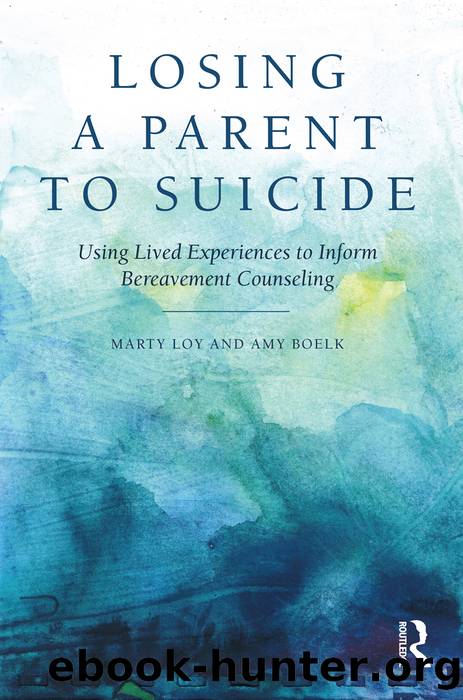Losing a Parent to Suicide by Marty Loy

Author:Marty Loy
Language: eng
Format: epub
ISBN: 978-1-135-07153-0
Publisher: Taylor and Francis
Preserving and Sharing Memories
The need to maintain a connection with a deceased loved one is historically well documented (Cohen, Mannarino, & Knudsen, 2004; Glass, 1991; Howarth, 2011; Stroebe & Stroebe, 1993; Worden, 1996). As such, efforts to keep the memory of the parent alive in the childâs world has been shown to be a protective factor in recovery, yet secrecy surrounding suicide is common in many families (Ratnarajah & Schofield, 2007; Ratnarajah et al., 2008; Simone, 2008). This takes form in families not grieving together at the time of death or not reminiscing about the deceased. Some children are not allowed to attend funerals to say good-bye or keep items belonging to the parent. The tendency to stop all talk and remove all material items pertaining to the parent who died by suicide is detrimental to children in the long run.
Silverman and Worden (1993) found the children in their study devoted considerable energy to connecting with the deceased in some way. They did this through dreams, by talking to the deceased, feeling the deceased parent was watching them, keeping the deceased parentâs belongings, visiting the grave, and frequently thinking about the deceased. According to Requarth (2006), âContinuing to talk about the parent who has died, telling stories, looking at pictures, and giving children mementos to treasure, are essential to helping a child cope with lossâ (p. 130). Adults should encourage children to talk about the deceased and involve them in rituals surrounding the death to ensure the best possibility for recovery (Kaslow & Aronson, 2004). Simone (2008) agrees, indicating that âto deny children and young people the chance to talk and remember their dead parent is denying them the opportunity to heal within a loving and supportive network. Sharing memories also allows for the children to re-construct their relationship with their dead parentâ (p. 46).
Our participants mentioned preserving memories of the deceased parent as a way to find comfort. They did this through talking with others, becoming the link to memories, and performing funeral and graveside rituals. Building remembrances of the deceased parent helped some participants by giving them something solid to hold onto.
Some participants preserved memories by reminiscing with others. Rachel believed that memories of her dad would have been lost had she not actively preserved them. She credited caring adults with helping her keep his memory alive. When she was young, counselors and teachers encouraged her to draw and write about things she remembered doing with her dad. As she got older, family members and friends of her father shared stories about his life and the circumstances surrounding his death. She felt that with each year, more and more people started coming forward to share things they remembered about her dad or ways that he was involved in her life that she would not remember.
Iâm thankful to have those memories now, and I think Iâve been able to really hold onto those memories because theyâre things Iâve talked about, and people have helped me remember. I think it probably would have been pretty easy to lose those memories if they had not been reinforced.
Download
This site does not store any files on its server. We only index and link to content provided by other sites. Please contact the content providers to delete copyright contents if any and email us, we'll remove relevant links or contents immediately.
Should I Stay or Should I Go? by Ramani Durvasula(7621)
Why We Sleep: Unlocking the Power of Sleep and Dreams by Matthew Walker(6654)
Fear by Osho(4696)
Flow by Mihaly Csikszentmihalyi(4656)
Rising Strong by Brene Brown(4411)
Why We Sleep by Matthew Walker(4394)
The Hacking of the American Mind by Robert H. Lustig(4338)
How to Change Your Mind by Michael Pollan(4315)
Too Much and Not the Mood by Durga Chew-Bose(4302)
Lost Connections by Johann Hari(4135)
He's Just Not That Into You by Greg Behrendt & Liz Tuccillo(3856)
Evolve Your Brain by Joe Dispenza(3633)
The Courage to Be Disliked by Ichiro Kishimi & Fumitake Koga(3438)
Crazy Is My Superpower by A.J. Mendez Brooks(3359)
In Cold Blood by Truman Capote(3345)
Resisting Happiness by Matthew Kelly(3322)
What If This Were Enough? by Heather Havrilesky(3286)
The Book of Human Emotions by Tiffany Watt Smith(3265)
Descartes' Error by Antonio Damasio(3247)
